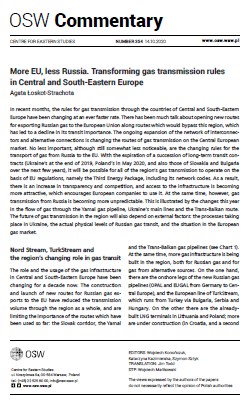More EU, less Russia. Transforming gas transmission rules in Central and South-Eastern Europe
More EU, less Russia. Transforming gas transmission rules in Central and South-Eastern Europe
Author(s): Agata Loskot-Strachota
Subject(s): Energy and Environmental Studies, Environmental and Energy policy, International relations/trade, Political behavior, EU-Accession / EU-DEvelopment
Published by: OSW Ośrodek Studiów Wschodnich im. Marka Karpia
Keywords: EU; Russia; Gas transmission; Nord Stream; TurkStream; Gazprom; Ukraine; Trans-Balkan gas pipeline;
Summary/Abstract: In recent months, the rules for gas transmission through the countries of Central and South-Eastern Europe have been changing at an ever faster rate. There has been much talk about opening new routes for exporting Russian gas to the European Union along routes which would bypass this region, which has led to a decline in its transit importance. The ongoing expansion of the network of interconnectors and alternative connections is changing the routes of gas transmission on the Central European market. No less important, although still somewhat less noticeable, are the changing rules for the transport of gas from Russia to the EU. With the expiration of a succession of long-term transit contracts (Ukraine’s at the end of 2019, Poland’s in May 2020, and also those of Slovakia and Bulgaria over the next few years), it will be possible for all of the region’s gas transmission to operate on the basis of EU regulations, namely the Third Energy Package, including its network codes. As a result, there is an increase in transparency and competition, and access to the infrastructure is becoming more attractive, which encourages European companies to use it. At the same time, however, gas transmission from Russia is becoming more unpredictable. This is illustrated by the changes this year in the flow of gas through the Yamal gas pipeline, Ukraine’s main lines and the Trans-Balkan route. The future of gas transmission in the region will also depend on external factors: the processes taking place in Ukraine, the actual physical levels of Russian gas transit, and the situation in the European gas market.
Series: OSW Commentary
- Page Count: 9
- Publication Year: 2020
- Language: English
- Content File-PDF

